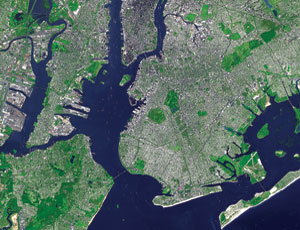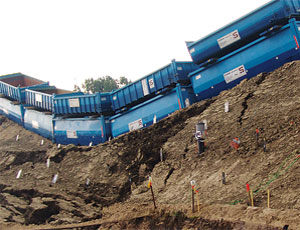At conferences and on Websites, at research centers and out on windswept coasts around the world, increasing numbers of engineers, scientists, planners and policymakers are gathering to share ideas and lessons learned about a growing threat to one of the linchpins of civilization: the delta regions of the world. Those fragile landforms, built patiently over millennia by the sediment deposited at the mouths of the world’s mightiest rivers, are home to great ports and commercial centers of the global economy. They are, by definition, low and coastal; they also are on the front line to suffer hard consequences from climate change, particularly from the sea-level rise widely expected to accompany projected global warming. Experts can debate the probability and degree, but nations depending on the deltas cannot afford to wait for nature’s demonstration.
“We learn lessons all the time but not from science, only from nature,” says Martin Van Der Meer, technical director at Fugro Water Services, Leidschendam, the Netherlands. He says it has always required major natural disasters to bring points home. Van Der Meer and other experts gathered in Amsterdam in February for Aquaterra 2009, the second biennial world conference on delta issues and climate change hosted by the Dutch. They are seeking to enlist science and technology to help predict risk more effectively and break that dangerous learning pattern.
There is a surge of study and project planning going on, and the Dutch have a global role—but so do many others as the knowledge transfer accelerates.
U.S.-based IBM Corp., for example, is a key player in an ambitious series of experiments at a facility called the IJkdijk in the Netherlands, where a consortium of agencies and companies have built a full-scale dike testing facility. The newly opened site features a series of heavily instrumented test dikes, or levees, which will be destroyed by various processes. IBM is participating to refine systems for centrally collecting, monitoring and interpreting the data that is generated, not only when flood-control structures fail but as they simply stand at rest, year after year. Dutch-based Fugro and other companies that make analysis tools, sensors and instrumentation devices are also simultaneously transferring their learning from tests at the IJkdijk to the U.S. and other countries around the world.
Surge Barriers
Knowledge of effective surge-barrier planning and construction also is spreading after successful experiences blocking surge with barriers at Rotterdam and on the Thames in England. A barrier in Singapore has just been completed, and massive gates now are under construction in New Orleans.
A conference organized by academics and engineers in New York City scheduled for March 30-31 at the Polytechnic Institute of New York University in Brooklyn will examine new concepts for storm-surge barriers to protect New York City. It will be hosted by the American Society of Civil Engineers’ New York Metropolitan Section Infrastructure Group and the New York Academy of Sciences.
The conference is a grassroots dialogue bubbling up from the professional community’s concerns that the exposure of New York City’s dense population and infrastructure to storm-surge and sea-level rise is being ignored. “Congress won’t likely authorize the U.S. Army Corps of Engineers to study the effects of global warming on New York or any other city without public support, which usually comes after the disaster,” says conference originator Douglas Hill, a consulting engineer and adjunct lecturer at the School of Marine and Atmospheric Sciences at Stony Brook University, Stony Brook, N.Y.
Hill’s article “Must New York City Have Its Own Katrina?” published in “Leadership and Management in Engineering” in July, 2008, helped kindle the debate. He argues that the city has had enough near misses with storm-surge disasters to suggest the threat is real, even without sea-level rise or climate change. But he also suggests New York Harbor’s geography lends itself to defense. Two or three barriers could shield trillions of dollars of assets and millions of lives, he says.
Four engineering firms—Arcadis US, Denver; Parsons Brinckerhoff, New York City; Halcrow Group Ltd., London; and Camp Dresser & Mckee, Cambridge, Mass.—have taken up the challenge of developing concepts to close the mouth of the harbor, as well as choke points on the Arthur Kill behind Staten Island, the Verrazano Narrows between Staten Island and Brooklyn and Hell Gate at the southern reach of Long Island Sound.
Holland received its big lesson in 1953, when a 5.6-m storm surge inundated almost 10% of the country and killed 1,835 people. It has been reviewing that lesson after the shocking calamity in New Orleans caused by Hurricane Katrina in 2005. The U.S. is still digesting that event. After both floods, the initial reaction was the same: a binge of construction for surge protection and levee strengthening. But the long-term solution now is far more nuanced than the 50-year campaign to fortify the Netherlands with 10,000-year storm-surge protection and a vow of “never again.”
The difference between 1953 and today is the Dutch experience of living with the fortifications they built, which channelized rivers and closed off some estuaries, with serious environmental consequences. There also is a fear among water resource officials that the “never again” pledge has not brought reassurance, only dangerous complacency. Even nature’s rules of the game may be changing. “With climate change, everything we know isn’t true anymore,” says Van Der Meer.
Prior to Katrina and other unsettling events there were no practical evacuation plans for the 8 million people living well below sea level in Holland on land stolen over the past 1,000 years from the waters. In a land of “10,000-year storm protection” and the mantra “never again,” there was no reason for planning a mass evacuation.
But Katrina posed a “what if” question that rocked Dutch self-confidence. It was further undermined by a couple of other incidents in California and the Netherlands. Flood-control experts refer to them as “blue sky” failures, which happen in calm weather under normal water conditions when apparently sound dikes and levees suddenly give way. One happened in the California Delta in June 2004 when a section of levee protecting a 12,000-acre island called the Jones Tract suddenly breached, allowing the water to drown the farmland inside for no identifiable reason. Another occurred in 2003 at Wilnis in the Netherlands when one side of a dike channeling a canal suddenly slid into the neighborhood behind, bringing a flood surging through. Blue-sky failures give flood-control experts nightmares.
Five-Year Plan
The Dutch started making national engineering assessments of their protections every five years in 1996, and they were not pleased with the findings, especially as follow-ups turned up even more deficiencies in levees thought to be well maintained. “Never again,” was beginning to sound like a fool’s boast. Planners rethought the confrontational approach.
The Dutch introspection was a theme at the first Aquaterra conference, in 2007, in which ideas for working with, rather against, nature were much discussed by international attendees representing delta stakeholders from watersheds throughout the world. Creating “room for the river,” was one idea, which seeks to enlarge upstream floodplain buffers to absorb and mitigate the shock loads of cresting rivers surging downstream. Another was the idea of restoring some of the natural coastal transition zones and estuaries that had been walled off from the sea during the wave of construction since 1953.
Those ideas resonate in the Louisiana delta, where generations of engineers have channelized the Mississippi to the point that sediment has long ceased restoring the dwindling coastal buffer zone with periodic soil-laden floods. They also resonated with engineers and planners in other delta landscapes, from Egypt and India to Bangladesh and China.
The new Dutch philosophy can be described as one of “building with nature” and developing natural climate buffers to dissipate the forces of floods before confronting them with constructed protections. “Nature when possible, technology when required,” explains Van Der Meer.
The approach combines recreational development in both rural and urban environments with the expansion of natural climate buffers for water management. Measures range from restoring estuaries to...




Post a comment to this article
Report Abusive Comment